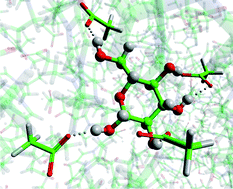Neutron diffraction, NMR and molecular dynamics study of glucose dissolved in the ionic liquid 1-ethyl-3-methylimidazolium acetate†
Abstract

* Corresponding authors
a Atomistic Simulation Centre, School of Maths and Physics, Queen's University, Belfast, UK
b
QUILL Research Centre, School of Chemistry and Chemical Engineering, Queen's University, Belfast, UK
E-mail:
c.hardacre@qub.ac.uk
c Department of Chemical Engineering and Biotechnology, University of Cambridge, UK
d Rutherford Appleton Laboratory, Chilton, Didcot, Oxon, UK

 Please wait while we load your content...
Something went wrong. Try again?
Please wait while we load your content...
Something went wrong. Try again?
T. G. A. Youngs, J. D. Holbrey, C. L. Mullan, S. E. Norman, M. C. Lagunas, C. D'Agostino, M. D. Mantle, L. F. Gladden, D. T. Bowron and C. Hardacre, Chem. Sci., 2011, 2, 1594 DOI: 10.1039/C1SC00241D
To request permission to reproduce material from this article, please go to the Copyright Clearance Center request page.
If you are an author contributing to an RSC publication, you do not need to request permission provided correct acknowledgement is given.
If you are the author of this article, you do not need to request permission to reproduce figures and diagrams provided correct acknowledgement is given. If you want to reproduce the whole article in a third-party publication (excluding your thesis/dissertation for which permission is not required) please go to the Copyright Clearance Center request page.
Read more about how to correctly acknowledge RSC content.
 Fetching data from CrossRef.
Fetching data from CrossRef.
This may take some time to load.
Loading related content
